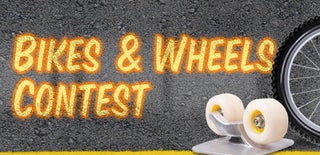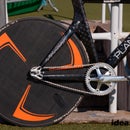Introduction: Carbon Fiber Handlebar With Integrated LEDs
This instructable describes how to make a unique handlebar/stem combo using carbon fiber and aluminium. The design allows seamless integration of LEDs and batteries.
A milling machine is needed for the stem and composite lay-up supplies for the handlebar. A 2,5 axis NC-milling machine and vacuum bagging system is recommended. We made use of laser cutting, water-jet cutting and 3D printing, but they can be replaced with manual cutting and sculpting.
The handlebar consists of a sandwich structure with two identical curved skins or faces, two mirrored corrugated cores and two mirrored tubular handles. The stem consists of a main body, clamp and face plate. The design shown here has two rearward facing 3x3 red LEDs, one 4x4 white LED array facing forward and a push button switch with a blue background LED. The system is powered by four CR2032 button batteries. The whole package is very light and has excellent torsional stiffness even-though it is not a tubular structure.
Updates etc. will be up on the project's website later this year http://www.ideas2cycles.com
Step 1: Design
The stem
The stem was designed to accomodate batteries and LEDs inside and also to provide a surface for bonding the handlebar onto. A 2"x2" 6061 aluminium alloy stock was used for the main body and the clamp. The face plate was water-jet cut from 1/8" aluminium alloy sheet. Eight M4x0,7 mm steel bolts were used for hardware.
The handlebar
The handlebar uses a (pseudo)aerodynamic open sandwich structure with curved faces (or skins) and a transverse corrugated core. The design process started by setting a center-to-center dimension of 420 mm for the handles and placing them to where a bullhorn handlebar would be gripped. A mild forward sweep and a shallow drop was selected. The faces are 50 mm wide at the stem and taper to 35 mm toward the handles. They are fabricated identical and both have a 250 mm radius of curvature that results in the drop of the handlebar. The faces are 40 mm apart at the stem and become closer each other towards the handles. The handles themselves are 25 mm in diameter and morph into a near square shape between the faces. They can be made to accomodate time trial brake levers if needed.
Step 2: Fabrication
The stem
The stem was machined using a 3-axis CNC milling machine. Surfacing was used at the bottom of the deep pocket but the design is basically 2,5D and requires only an NC-milling machine with simple conversational programming capabilities. A skilled manual machinist could do a simpler design on a manual milling machine. The main body of the stem took seven CNC-operations and the clamp took two. Only a vice was used for attaching the work piece. No jigs are needed. The tool paths and tools used can be seen from the pictures.
The handlebar
The front profile of the handlebar was water-jet cut from 3/4" MDF and used as a guide for bending aluminium sheet to the same shape. The aluminium sheet was glued to the MDF to make the mould for laminating the skins (or faces). One could also simply use the bent aluminium as a face for the sandwich structure. The flattened top view of the handlebar was laser cut from 1/32" balsa wood. This will give the forward sweep of the handlebar without the need for trimming carbon. The balsa wood was painted black and carbon fiber braid was used to cover it. The reinforcement was wetted with epoxy and vacuum bagged against the mould. A second face was made identically, except two pairs of wires were taped to the balsa wood for a certain distance. The wires were pulled from under the carbon braid approximately where the handles would be attached and lamination was done normally.
A corrugated core was drawn in CAD and the lengths of the straight sections were made into a bending table. The distances were marked on both edges of an aluminium sheet and the marks were connected. The sheet was bent along those lines to produce the mould for the corrugated core. One could simply use the aluminium sheet as the core, as well. Unidirectional carbon tape was laminated on the core mould with a slight sweep to match that of the top view of the handlebar. A mirrored core was made using the same mould by having the sweep go the other way. The mould of the core was pressed on the mould used for the skins/faces to have matching curvature viewed from the front.
The handles were 3D-printed to get the shapes needed. One could also just sculpt something out of foam. Carbon fiber braid was put on the the 3D-prints and it was wetted with a epoxy resin system. Pressure was applied on the laminate by wrapping it in perforated electrical tape. The perforations were drilled free hand on the tape roll and provide a means for excess resin to escape. At the same time it gives the same look as handlebar tape does, but on a carbon fiber part.
Step 3: Assembly
Assembly can take place once the stem is machined and all carbon fiber parts are laminated. The stem should be deburred and cleaned with acetone. The faces for the handlebar need to be trimmed from the edges with a straight cut and degreased. The handles need to be trimmed from both ends. A hacksaw works great. A file and sandpaper can be used for cleaning up the cuts. The whole structure is bonded in one step in the same mould as the faces were laminated in. This way pressure can be applied on the package while the adhesive cures. A two-component non-sag epoxy adhesive that cures at room temperature is recommended. No clear coat is needed if the surface quality is good straight from the mould. We've found PVA to give better results compared to other mould release agents.
The LEDs can be attached and wired once the bonding is complete. We used 12V LEDs meant for car use with four CR2032 batteries. Obviously all the LEDs were connected in parallel with the push button acting as a switch. We expect the battery life to be over one hour with the current batteries. With less LEDs and bigger batteries the life goes up.

Second Prize in the
Bikes and Wheels Contest













